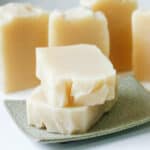Pure Olive Oil Castile Soap Recipe
Olive oil, renowned for its skin-loving properties, takes center stage in this timeless cold process Castile Soap recipe, ensuring a luxuriously cleansing experience. This classic soap is perfect if you're looking for a pure, natural soap experience. This soap recipe comfortably fits a 42 to 48 oz log mold.
Applications: 11 4 oz bars
Equipment
- Scale
- Stock Pot - 8 quart
- Silicone Spatula
- Nitrile Gloves
- Goggles
- Face Shield
- Chemical Resistant Apron
- Stick Blender
- Thermometer
- 42 oz log mold, silicon lined
- 48 oz log mold, silicon lined
- Freezer paper
Ingredients
- 7.0 oz Water distilled water or tap water
- 4.1 oz Sodium hydroxide dry, beads or crystals
- 32 oz Olive Oil extra virgin, pomace, or golden
- 1½ oz Lavender essential oil Optional
Instructions
Prepare The Lye Solution
- Weigh your water in a safe, plastic pitcher. Set to the side.7.0 oz Water
- Weigh the sodium hydroxide, and carefully add it to the pitcher of water, stirring until dissolved. It will look milky, or cloudy. Set aside and wait until it is no longer cloudy, and cooled to about 110 - 115 degrees F.4.1 oz Sodium hydroxide
Measure and Heat the Olive oil
- Place your stockpot on a scale and tare it to zero. Measure the olive oil directly into the tared stockpot on the scale.32 oz Olive Oil
- Remove the stockpot from the scale and heat on the stovetop until it reaches between 110 and 120 degrees F. This starting heat will give the olive oil molecules a ‘boost’ and get us to a medium trace sooner, without burning out the motor on the stick blender.
Stick Blend and Bring to Trace
- Slowly pour your lye solution in a thin stream into your warmed olive oil. Stir slowly with a spoon while you pour until all the lye solution has been emptied into your oils.
- Stir with your spoon until the mixture is cloudy and holding together, then start using your stick blender on low.
- If adding lavender essential oil, do so now.1½ oz Lavender essential oil
- Gently stick blend and bring your soap mixture to a light - medium trace. Trace is when the oils and lye solution have emulsified and thickened. Ideally, you'd like your Castile soap mixture to have the consistency of pancake batter, where it coats a spatula. If you get a thicker trace that's even better, as it lets you create “peaks", or texture after you pour it into a log mold.
Pour Traced Soap Into A Mold
- Once you are at a light to medium trace, you can pour your soap into a single mold or into individual molds.
- Tap the filled mold on your work surface a few times to eliminate any air pockets or bubbles.
Unmold and Cure The Bars
- Let your soap sit covered with a mold cover or a towel to set up. It will most likely go through a gel phase. Do not try to take it out of the mold for at least 3 days though, as it will be too soft to handle before this. It is normal to have to wait up to 2 weeks to remove from the mold, depending on the variety of olive oil you used. This is normal.
- Once your soap can be easily handled, remove from the mold. For logs, slice into bars immediately.
- Place the bars of soap in a location that has some free flowing air, is not moist, and can remain undisturbed for several months. On top of a book shelf, spare closet, or even a shelf in your laundry room or garage.
- Check your soap bars every month, turning them. Cure for one year for fully cured 100% olive oil Castile soap. The lather will have much more bubble, and you won't get that slimy skin that immature Castile soap creates.
Notes
- Making soap involves handling lye, which can be dangerous if not handled properly. Please ensure you research safety precautions thoroughly before attempting this project.
- Keep your lye solution and olive oil no hotter than the 110 - 120 degrees F range, as too hot can contribute to volcano overflow in some molds (deep, wood insulated).
- Use a light hand with the addition of the lavender essential oil if you include it. It can regress trace even more! You just want enough to add a hint of lavender, about ½ oz per pound of oil.
- Let the soap sit in the mold as long as it needs to become firm and easy to unmold. This can take up to 2 weeks depending on the grade of olive oil you chose. Extra Virgin Olive oil will be the slowest to firm up.
- For soap that sets up a little faster, dissolve 1 teaspoon of salt to 1 tablespoon of water. Add after you first mix in the lye solution.
